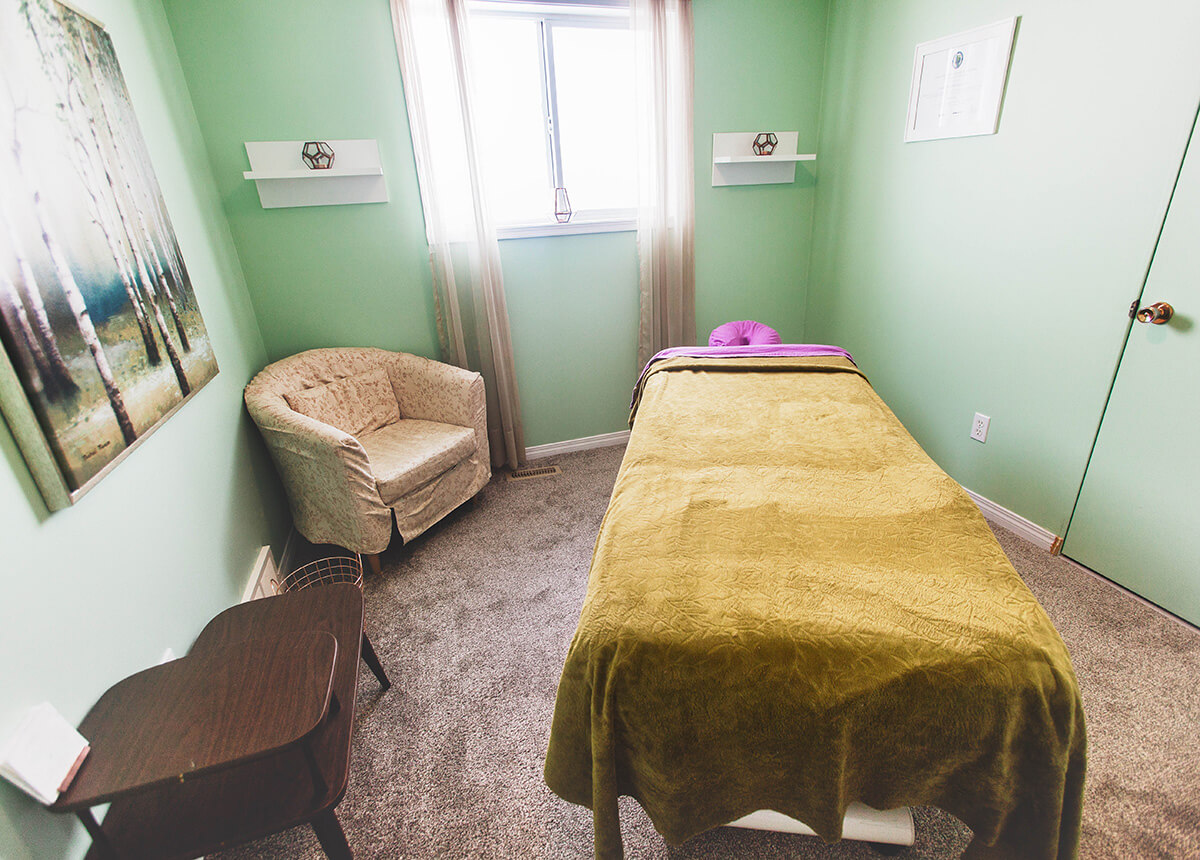BIO

Kimberley is a graduate of Grant MacEwan university’s 2200 hour massage therapy diploma program and has been a registered massage therapist since 2011. Her mother took a massage therapy course while pregnant and then continued to teach infant massage with Kim as a demo baby.
The passion for massage then transferred to Kim, who got massage treatments herself as a teenager to treat shoulder pain from playing the french horn for 6 hours per day.
Kimberley’s main goal with massage therapy is to help clients continue to do their favorite daily activities even when pain and overuse injuries prevent them from doing so. She is a self-described old soul who enjoys listening to classical music and ballroom dancing in her spare time.
Massage FAQ
Massage therapy is, by definition, the manual manipulation of soft tissue for a therapeutic effect done with a knowledge of anatomy, physiology, and an understanding of the interaction between the body, mind, and spirit. Massage can help decrease pain, inflammation, and muscle tightness while increasing range of motion and relaxation.
I graduated from Grant MacEwan’s 2,200 hours two-year massage therapy program in 2011. Most health benefit and insurance companies will only accept direct billing from massage therapists with a minimum of 2,200 hours of training. Massage therapists are required to take continuing education courses to further their knowledge and skills. I have taken further courses in Hot stone massage, Jaw/TMJ massage, Deep tissue fascia massage, Acupressure, Infant and pregnancy massage.
Your first massage session begins with you filling out a health history form. It is important for your massage therapist to know about your current health, health history , allergies and medications. The therapist will then go through the form with you and ask specific questions if further information is needed. We will discuss your reason for seeking treatment, main complaint, pressure preferences and your level of comfort with clothing removal. If there is direct billing to be processed, this will be done before treatment so that the client is aware what amount of the treatment is covered. The therapist will leave the room to let you change and ask that you are either face up, face down or lying on your side for the start of treatment. The therapist will knock and ask if you are ready and are covered with the sheets. Then treatment will proceed. The level of interaction with the therapist during treatment depends on the client’s preference. Some clients prefer to be left to their own thoughts and focus on the massage treatment. In this case talking will be kept to a minimum with the therapist speaking once or twice to check in on pressure or asking the client to turn over. Other clients find talking to be therapeutic and will have conversations or ask the therapist questions during treatment. The therapist will let the client know when the treatment time is up and leave the room to let them change. Homework such as stretches, muscle strengthening, range of motion exercises or hydrotherapy may be given. After treatment payment will be processed and the client will be given a receipt and a health benefits claim printout if applicable. The client can reschedule directly after treatment or later at their own convenience with online booking.
Clients are encouraged to undress to their own comfort level. Certain massage strokes can be done overtop of clothing to treat muscles without removing all clothing. Draping, or sheets, are used in massages in north America to provide a sense of boundaries between the client and therapist. Body areas that are not being worked on are covered by the sheets, leaving only the area being massaged exposed.
Most massage strokes are directed towards the heart. This results in increased blood flow and causes the feeling of relaxation one experiences after a massage. Light-headedness can also be expected after the first time one experiences a massage.
Certain massage stokes and types of massage can feel more intense than others. This is why it is important for the client and therapist to agree on a treatment plan and level of pressure during the massage. It is common for clients to feel some muscle soreness for up to three days after a deep tissue/fascia release massage. Bruising occurs rarely after treatments, please notify the therapist if this happens so it can be noted in their medical legal charts.
The therapist will make a treatment plan and suggest how often massage treatment should be sought out. For an acute injury, treatment can be suggested weekly to every other week. Body maintenance massage is suggested approximately every 4-8 weeks depending on the individual.
Direct billing is a relatively new technology for massage therapists and a privilege, not a right. Therapists must uphold high ethical standards when using direct billing portals. When billing works it is wonderful for therapists and clients, however, there are still system hiccups and variances. For this reason, clients are asked to bring a backup form of payment, in case direct billing does not work
There are many different reasons why direct billing will not go through which can cause client frustration. Please be aware that reception is only the messenger of an insurance company’s predetermined response. Claim refusal is usually due to regulations set up by specific health benefits plans. Reasons can include:
Plan requirement states that a doctor’s note is needed for treatment or having a doctor’s note expire after a year of use.
Some health benefits plans will only pay the insured member, not the servicing provider. In this case, the therapist can submit the direct billing paperwork on the client’s behalf. The client will need to pay the therapist directly for treatment and will receive the treatment amount directly from their health benefits provider at a later date. It really should be called runaround not direct billing in this case.
Some health benefit plans will only pay for a percentage of the massage. In this case, the balance owing is paid directly to the therapist.
Benefit coordination happens when a client has their own coverage and is also covered by a spouse’s plan. The client’s primary benefits must be exhausted first before their spouse’s coverage can be used. This is the most complicated level of direct billing. Some clients find it easier to pay for their massage out of pocket and submit the billing themselves since it must be done in a specific order and the health benefits companies make it a hassle to redo if it wasn’t done correctly the first time. With children, the billing is first submitted under the parent whose birth date is earlier in the year.
An electric massage table that rises and lowers with a foot pedal is what the client will be lying on. The table is made with many inches of soft foam and is designed for client comfort, even when lying face down. A table warmer can also be set to the client’s heat preference. The table also has a lift so that clients with heart conditions and in the third trimester of pregnancy can be treated from semi seated positions.
Therapist Kimberley prefers to use massage lotion in therapeutic treatments, as it absorbs quickly and clients don’t have to worry about toweling off excess oil. Massage lotion or gel is recommended for hairy clients. Oil is used exclusively during hot stone treatments so that the stones can glide properly. Massage lotion (Bon Vital Natural) contains jojoba, safflower and sesame seed oil, green tea leaf extract and algae extract. Massage oil (Bon Vital Natural) contains safflower, grapeseed, jojoba and soybean oil, peach and apricot kernel oil, algae and green tea leaf extract, vitamin A and E. Lavender or mint oil is offered at the end of massage treatments as an aromatherapy bonus. Scent is optional and can be declined.
If allergies are a concern, please bring this up to the therapist’s attention prior to treatment.
Sheets are washed after each use with unscented laundry detergent.
Please refer to my online booking system for exact hours of operation.
Hours of operation are
Mondays 2-9pm,
Wednesdays 2-9pm,
Thursdays 2-9 pm,
alternating Fridays/ Saturdays 10AM-5PM
Sundays 10am-5pm.
Morning appointments are availible by request.
Since this is a home operated business, bookings are by appointment only. No walk ins.
Tranquil Therapies accepts debit and credit card payments through a card reader point of sale system as well as cash payment methods. Direct billing is also available with select companies.
Direct billing supported health benefits companies:
Blue cross (ASEBP, ARTA)
Medavie Blue cross (RCMP, Veterans affairs)
Quickcard
Telus Health Portal (chamber of commerce group insurance plan, Cowan, Dejardins, Great west life, Ia financial group, Johnson, Johnston group, Manulife, Maximum benefit, and Sunlife financial)
Coverage amounts and whether the servicing provider or client is paid deffer by health benefits plan and by company. Please refer to the why is my direct billing working section for more in depth information on this subject.
It is recommended that clients reschedule as soon as possible so that another client can fill available appointment slots and avoid a loss of income for the massage therapist.
Clients who no show for appointments will be changed a twenty dollar no show fee to make up for therapist’s time.
No shows or late cancellation appointments cannot be run through health benefit plans, as this is insurance fraud. It is a serious offense that could result in the massage therapist losing their license to practice.
Multiple no shows will result in prepayment being required to book appointments or termination of the therapist client relationship.
Illness or an emergency on either the therapist or client’s behalf will result in the rescheduling of an appointment.
Treatment Room

